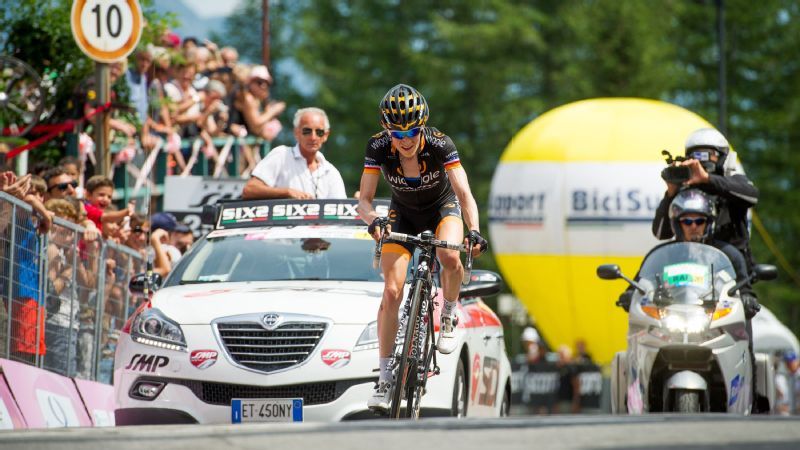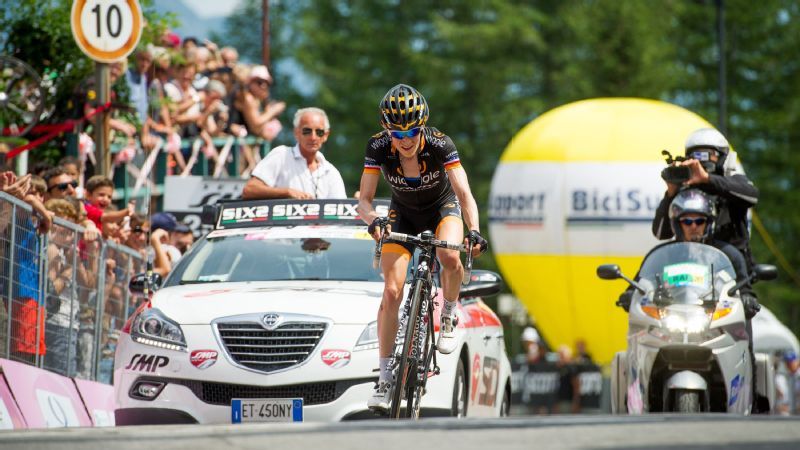
Mara Abbott on her way to a solo stage victory in Stage 9 of the 2015 Giro Rosa.
If I had known as a college freshman — entering into adulthood of honing pure excellence in my tiny sphere, with errors and triumphs and struggles all rolled in — if I had known this fate lay ahead, would I have traded my cycling career for a stronger hip?
In August 2016, I retired proud of my accomplishments after a decade as a professional road cyclist with two overall wins in the Giro Rosa in Italy, two national championship titles and a fourth-place finish at the Rio Olympics. With neither interest nor intention to delve into who I was if not an elite athlete, I decided to become a runner — ideally of the level that would win an Olympic medal.
Then I got a stress fracture in my right hip. I am former cyclist with no lifetime hours banked in weight-bearing activities and a history of an eating disorder. My downfall felt so clichéd that in self-punishing humiliation I tried to hide my limp. If I said “hip flexor strain” to you, I apologize. That was a lie.
The ensuing bone scan revealed low bone density. Competitive cyclists are more than two times more likely than the recreationally active population to end up this way.
“Would you do it differently if you could go back to the beginning of your career?” my new nutritionist asked.
That career was my passion, my life’s work. It might have etched injuries into my bones, but it also revealed resilience and determination, taught me self-reliance, equanimity and faith. It allowed me to reach with pure and honest focus, the limit of my potential.
It seems that I had never realized how much it all meant to me because I startled even myself with the readiness of my reply: No.
***
Leaving professional sports is hard. Everyone warned me about this and I ignored them. My personal transition is complicated by Boulder, Colorado — which aside from being where I was born and raised, also happens to be endurance athlete mecca. If we had entrance forms for our city, right next to ethnicity and gender there would be a checkbox for “athlete type”: climber, runner, cyclist, triathlete or that last box where I now find myself: “not identifying.”
Strangers here blithely ask: “Look at those legs. What are you?” I refuse classification, telling them that I work at a local farm, which is technically true despite one serious historical omission. Watching their confusion is far more fun than hearing the insidious answer between my ears. “I’m nothing.”
The competitive void made me surly.
It also made me question everything. What does it mean to be an elite athlete? We might be the pinnacle of human strength, speed or mental dedication, but that does not always make us the pinnacle of health. Is it possible to devote oneself fully to a sport while living a healthy and robust life?
Injuries, missed weddings, skipped parties and hours of training aren’t the only sacrifices for a life in sports.
In June 2016, I told only my coach — just before my final Giro, just before the Olympics — my newest revelation: In pursuing greatness, perhaps my greatest concession was breadth.
To maintain focus, to find safety in a world of constant risk and uncertainty, I learned to create mental quiet. I muted emotion, removed stimuli and simplified. I successfully muffled doubt and fear, but some of my joy, inspiration and honest self-reflection suffered collateral damage. After a decade of closing door after door in my mind to distraction, I suddenly realized that my inner world had grown small. It felt perfect and beautiful, each facet polished to an exquisite shine with years of utmost dedication. It began, however, to feel just a bit bare.
It was my privilege to make the sacrifices — it was always my choice. Financially, I hovered just above the poverty line for my entire career, but so do many traditional minimum-wage workers. I barely cracked half the minimum salary for a Pro Tour man, but I knew the costs, never had any false impressions about my projected payout, and each year, I signed on the dotted line. In any case, my budgeting skills are now world-class.
***
Laid up with my stress fracture and forced by the sports gods into a bit of self-reflection, I researched ailments of avid runners. I was appalled by the magnitude of tendinitis, strains, sprains and self-induced broken bones readily accepted as an occupational hazard.
“Who would put themselves through that?” I wondered. “How could that possibly be OK?”
I am, of course, the one who had decided to devote my life to a sport that involves semi-regular episodes of hurtling oneself to the ground at 50 kph.
***
I quit racing in 2011, for a year after acknowledging that I had a serious eating disorder. A few months in, I was ponderously riding alone when a stranger pedaled up next to me.
“Your calves are amazing,” she said. “How did you get them so cut?”
Having recently come to terms with the idea that my eating disorder could kill me, I confess, I was speechless. She pedaled off, probably considering my silence either arrogant or unfriendly. In a state of imagined bravery, I wished she had waited only a few moments longer to hear: “Do you really want to know why my calves look like this?”
Eating disorders have the highest mortality rate of any mental illness. One study also found them to be 2-3 times more common in competitive athletes than the general population, particularly among endurance sports. It’s not just the girls, either — a female friend who struggled with multiple eating disorders during her professional cycling career told me of her training partners and friends, “It was boys who taught me the dirtiest and most harmful tricks of the eating disorder trade.”
After Stage 16 of this year’s Tour de France, Polish rider Pawel Poljanski posted a photo online of his legs, a terrifyingly flawless, skin-bursting map of every vein in the lower human anatomy. Some defended the look, talking of power-to-weight ratios up Alpine passes. In 2014, cyclist Bartosz Huzarski fended off accusations of doping after posting a similar photo. Huzarski explained — it’s not drugs; the image was normal for a cyclist of his level: “What you see in the picture is not unhealthy.”
Accepted, yes. Expected, perhaps. Healthy?
A study by JAMA in July found chronic traumatic encephalopathy, a neurological disease linked to repeated concussions, in 110 out of 111 brains of former NFL players. Those with CTE suffer memory loss, confusion, impaired judgment, aggression, depression, anxiety and sometimes suicidal behavior.
Most elite athletes are at least peripherally aware of our physical and emotional risks. We know the odds. To truly devote yourself to a sport, to honestly chase “best in the world,” you must believe yourself capable of something that no one else can accomplish. You must believe that every day. In a distribution of 110 out of 111, the elite athlete is habitually conditioned to believe that she will be the “one.”
***
Professional or amateur — we each have our own inescapably personal calculus of what is “worth it.” After all, masters cyclists also suffer from low bone density, and everyone crashes. Amateur weightlifters take steroids, and kids in contact sports take hits to the head.
Flirting with the edge of potential is dazzling, intoxicating and breathtakingly addictive. I really, really get it. But a true champion must have equal parts of strength and wisdom — and achieving physical excellence should not get carte blanche in the risk-benefit equation of a lifetime. In a moment of vulnerable honesty, what, for you, is worth it? Each answer is utterly unique — and constantly evolving.
Since my days as a high school swimmer, my reply was instinctual and clear.
“Anything.”
After a year of retirement, it is that pure certainty of purpose that I miss the most. On the wobbly legs of my uncomfortably new self, with a freshly healed hip, I’m no longer sure of my answer. I wouldn’t change the past. But with regard to the future? For the first time — consciously — I’m asking, too.
[“Source-espn”]